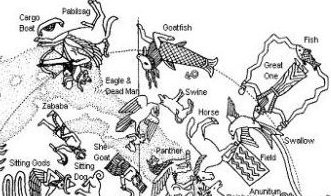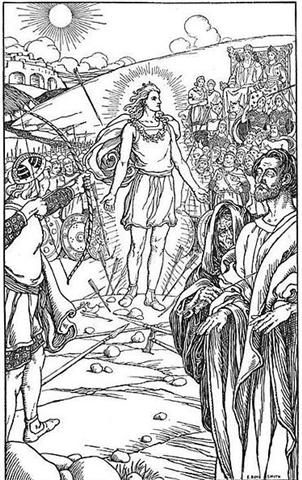I guess Allen's digression
to the subject of celestial spheres
originated from his associating Antinous
with Etana
who was uplifted very high by the Eagle.But
I have not found any reference in Allen to
the Babylonian Eagle & Dead Man:

...
There is also a Finnish folktale which repeats
the well-known Babylonian story of Etana and the
Eagle.²
²
See M. Haavio, Der Etanamythos in Finnland
(1995), pp. 8-12; also S. Langdon, The Legend
of Etana and the Eagle (1932), pp. 46-50.
Here, instead of the King, it is the 'Son of the
Widow' (no reason is given for this epithet,
which appears to belong to Perceval in the first
line, but we find it again in later Masonic
tradition)³ who is taken up into the air by a
griffin and sees the earth growing smaller and
smaller under him.
³
Such words have long lives. At the height of
Pickett's Charge at Gettysburg, the first man
over the wall was Gen. Armistead, who fell into
the breach mortally wounded. To those who picked
him up, the general kept repeating: 'I am a Son
of the Widow' - obviously the password of a
secret military brotherhood that his captors did
not understand, nor the historian eíther.
When the earth appears 'no bigger than a pea'
(analogous similes are to be found also in
Etana), the griffin plunges straightaway to the
bottom of the sea, where the hero finds a
certain object for which he had looked
everywhere, and finally he is restored to land.
This looks like the full story of what in the
Babylonian cuneiform is interrupted halfway
through because the tablet is broken off: it
might be the first version of the legend of
Alexander exploring the Three Realms ...
A circle is a two-dimensional picture of a
sphere, and all the arrows where the Milky
Way is ascending from the region of
the Archer means the way forward is barred.
Life ends here:

|
19 |
Al Baldah |
City |
π Sagittarii (Al Baldah) |
290.1 |
January 5 (370) |
41 |
279 |
|
January 4 |
5 |
6 |
|
July 5 |
6 |
7 (188) |
 |
 |
 |
|
Cb11-11 |
Cb11-12 (264) |
Cb11-13 (657) |
|
te ariki |
te moko
ariga
moe |
moko moe |
|
19h (289.2) |
Al Baldah-19 |
Aladfar (291.1), Nodus II (291.5) |
|
Manubrium (288.8),
ζ Aquilae
(288.9),
λ Aquilae (Ant.)
(289.1), γ Cor. Austr. (289.3), τ
Sagittarii (289.4), ι Lyrae (289.5) |
δ Cor. Austr. (289.8),
AL BALDAH,
Alphekka Meridiana (290.1), β Cor.
Austr. (290.2) |
|
7h (106.5) |
Wezen
(107.1) |
δ
Monocerotis (107.9) |
|
Alzirr
(105.7), Muliphein (105.8) |
|
January 7 (372) |
8 |
|
9 |
|
July 8 |
9 (190) |
10 |
 |
 |
 |
|
Cb11-14 (658) |
Cb11-15 |
Cb11-16 (268) |
|
tagata ka tomo i
roto - i tona mea |
tona mea |
kua kake te tagata
- ki tona rona |
|
ψ Sagittarii (291.6), θ Lyrae
(291.8),
ω Aquilae
(292.1) |
ρ Sagittarii (292.6), υ Sagittarii
(292.7), Arkab Prior (293.0), Arkab
Posterior, Alrami (293.2) |
χ Sagittarii (293.6),
Deneb Okab
(294.0) |
|
no star
listed |
Wasat
(109.8) |
Aludra
(111.1) |
|
January 10 |
11 |
12
(377) |
|
13 |
14 |
|
July 11 |
12 (193) |
13 |
14 |
15 |
 |
 |
 |
 |
 |
|
Cb11-17 |
Cb11-18
(662) |
Cb11-19 |
Cb11-20 |
Cb11-21 |
|
e ika |
tagata - henua
hikihiki |
te inoino - ka hoi
ia |
ku hurihia mai te
tagata |
tagata iri |
|
α Vulpeculae (294.9), Albireo
(295.5) |
μ Aquilae
(296.3) |
ι Aquilae (Ant.)
(296.8),
κ Aquilae (Ant.)
(296.9), ε Sagittae (297.1),
σ Aquilae (Ant.)
(297.4) |
Sham (297.8), β Sagittae (298.0),
χ Aquilae
(298.3) |
ψ Aquilae
(298.8),
υ Aquilae
(299.1), Tarazed (299.3) |
|
Ghost-23 |
Al Dhirā'-5 /
Punarvasu-7 |
no
star listed |
Markab Puppis (114.7), Procyon
(114.9), α Monocerotis (115.4) |
σ
Gemini (115.7), Pollux (116.2) |
|
Gomeisa
(111.6), ρ
GEMINI (112.1) |
CASTOR
(113.4) |
Antares
(557) |
|
January 15 |
16 |
17
|
18 |
19
(384) |
|
July 16 |
17 |
18 |
19 (200) |
20 |
 |
 |
 |
 |
 |
|
Cb11-22 (666) |
Cb12-1 |
Cb12-2 |
Cb12-3 (277) |
Cb12-4 |
|
ki te vage Rei |
Te nuku |
te ua |
te
ika |
te henua ma te hua |
|
Sravana-23 |
Bezek
(300.8), ι Sagittarii (301.2),
Terebellum,
ξ Aquilae
(301.3) |
Alshain
(301.6),
φ Aquilae
(301.8), ε Pavonis, θ Sagittarii
(302.3). γ Sagittae (302.5) |
μ Pavonis (302.7) |
20h (304.4) |
|
δ Sagittae (299.6),
π Aquilae
(299.9), ζ Sagittae (300.1),
ALTAIR
(300.3),
ο Aquilae
(300.5) |
τ Aquilae
(303.8), η Sagittae (304.2), δ
Pavonis (304.4) |
|
Azmidiske (117.4) |
no
stars listed |
Drus
(119.9) |
Naos
(121.3) |
Betelgeuze (394) |
|
January 20 |
21 |
22
(387) |
|
July 21 |
22 (203) |
23 |
 |
 |
 |
|
Cb12-5 |
Cb12-6 (672) |
Cb12-7 (281) |
|
vai o maro hia |
oho te vae |
kua ku moe mai |
|
Shang Wei (305.2), θ Sagittae
(305.4) |
Tseen Foo
(305.6), ξ Capricorni (305.8),
Tso Ke
(306.4) |
Gredi (307.2), σ Capricorni
(307.5) |
|
8h (121.7) |
Regor
(122.7), Tegmine (123.3) |
Al
Tarf (124.3) |
|
ρ Puppis
(122.0), Heap of Fuel (122.1), ζ
Monocerotis (122.3) |
The 22nd
letter (of
24) in the Greek alphabet is
chi (Χ). The Phoenician alphabet ended with
taw as number 22. In rongorongo times the
star Sadalmelik (the Lucky King) rose with the
Sun in February 19 (415) and (415 - 80) * 24h =
22h:.
|
7 |
Winnowing Basket |
γ Sagittarii (Nash) |
Leopard |
(273.7) |
Dec 20 (354) |
354 = 335
+ 19 |
|
December solstice |
|
8 |
South Dipper |
φ Sagittarii (?) |
Unicorn |
(284.0) |
Dec 30 (364) |
364 = 354
+ 10 |
|
9 |
Ox / Herd Boy |
β Capricornii (Dabih) |
Buffalo |
(308.0) |
Jan 23 (388) |
388 = 364
+ 24 |
|
10 |
Girl |
ε Aquarii (Albali) |
Bat |
(314.8) |
Jan 30 (395) |
395 = 388
+ 7 |
|
11 |
Emptiness |
β Aquarii (Sadalsud) |
Rat |
(325.9) |
Feb 10 (406) |
406 = 395
+ 11 |
|
12 |
Rooftop |
α Aquarii (Sadalmelik) |
Swallow |
(334.6) |
Feb
19
(415) |
415 = 406
+ 9 |
|
13 |
House |
α Pegasi (Markab) |
Pig |
(349.5) |
Mar 6 (430) |
430 = 415
+ 15 |
Twice 11 ('one more') is the number of moko
glyphs in the text and then 2 more are added at
the end.
|












